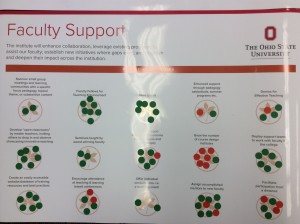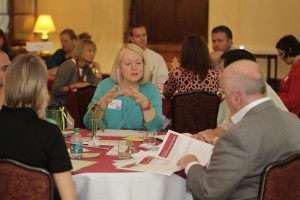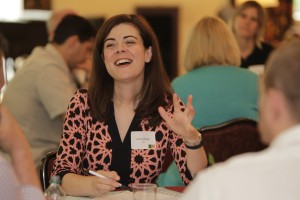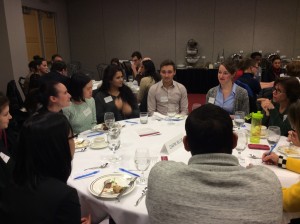At the March 25th convening of the faculty advisory council there was a strong focus on the new faculty development program proposal. The Council recommended that new faculty need to focus most on 1) Understanding how to effectively incorporate the range of tools and support available to enhance their teaching 2) To connect to active, cross-disciplinary teaching communities at OSU and within their cohort and 3) Take a scholarly approach to their teaching. The committee recommended the initial kickoff of the program be between 4 and 6 hours and an expectation of 15-24 hours of average participation over the course of the year. The Institute should ensure that there is a wide mix of activities and a strong role of mentoring.
Regional campus students offer recommendations for faculty development
On Friday January 29th, eight students from across the regional campuses came together to discuss the proposed Teaching and Learning Institute. Students offered insights on their best learning experiences. They then shared their thoughts on how faculty could best help them learn. Students emphasized the importance of a connection with their faculty member and how an individual note of encouragement can foster interest and inquiry. Students encouraged faculty to use Carmen consistently, allowing students to have a one-stop location for class materials. Regional campus students emphasized the importance of faculty members demonstrating their enthusiasm for the subject, which sparks their own interest. Students at all of the OSU campuses emphasized the importance of hands-on experiences in enhancing their learning.
Advisors offer suggestions for teaching and learning institute
On Friday January 29th, a focus group of advisors from across the University came together to offer feedback on how faculty can continue to develop and foster the success of students. Advisors are on the front line hearing from students about their best learning experiences and when they struggle. Advisors offered helpful tips that can benefit new and existing faculty. For example, making sure that office hours are posted and that faculty communicate and encourage students to take advantage of those office hours. Advisors noted the importance of students sensing a connection with faculty members. They also emphasized the importance of early alerts when students are struggling, encouraging faculty to reach out to students who may need extra help.
Students Offer Advice on Institute
On January 21st, approximately 50 students from across the University came together to discuss the proposed Teaching and Learning Institute. Students offered insights on their best learning experiences. They then shared their thoughts on how faculty could best help them learn. The insights from the students will be used to continue to revise the institute proposal.
January Teaching and Learning Convening
At the January 15th Teaching and Learning Initiative convening the faculty advisory committee came together to review and revise the draft institute proposal. The faculty advisors identified the strengths and weaknesses of the proposal and offered revisions.
Participants also responded to an initial concept for a faculty development activity, developed by the University Center for the Advancement of Teaching and the Office of Distance Education and E-Learning. Learn about the Concept for New Faculty Development.
Throughout the month of January there will be engagement with students, advisors, graduate teaching associates, and department chairs to gain their insight and thoughts on the institute proposal.
November Teaching Initiative Convening
The November convening focused on reviewing feedback from units across the campus to the draft institute proposal. There was significant participation from units across the campus, with significant interest, thoughts, and opinions about where and how teaching resources should improve across the University. A key point of discussion is about the array of teaching and learning related centers, programs, and resources. Do we need a whole new institute or should we be enhancing the centers/offices we already have? How would any institute be able to integrate these other activities? How can we make teaching and learning resources more visible and accessible? There were a number of questions around how the institute might define or support evidence-based metrics of successful teaching and learning?
Key units on campus engaged in supporting teaching and learning presented the work they do to support the university’s faculty. Several presenters provided presentation materials for sharing, included below:
University Center for the Advancement of Teaching
Office of Distance Education and eLearning
Center for Higher Education Enterprise
Center for Life Sciences Education
Department of Engineering Education
School of Teaching and Learning
This was followed by a discussion of the potential organizational structure of the institute, with small groups brainstorming how the institute could be organized. Debating whether it should be a virtual or physical institute and how the institute might be governed. There was a strong interest in having a proactive institute open to everyone, serving as a clearinghouse for teaching and learning resources. There was interest in a non-traditional institute structure, where leadership could rotate, be delivered in a distributed model, and/or integrate services across the institution.
 The last activity was to consider which of the many commonly suggested activities of the potential institute would be most important to pursue in the first year of the institute. A key initiative would be to communicate the identity of the institute. While the institute is still in the formative stage, it will be essential to have a clear identity for the institute. For example, in the area of faculty support there was strong interest in creating an “open classroom” program where master teachers invite others to drop in and observe, creating a showcase for innovative and effective teaching. Under inquiry and scholarship, there is strong support for creating a teaching and learning grants clearinghouse. In policy development there was strong interest, but also concern around how we create more substantive evaluation of teaching performance in the annual review process.
The last activity was to consider which of the many commonly suggested activities of the potential institute would be most important to pursue in the first year of the institute. A key initiative would be to communicate the identity of the institute. While the institute is still in the formative stage, it will be essential to have a clear identity for the institute. For example, in the area of faculty support there was strong interest in creating an “open classroom” program where master teachers invite others to drop in and observe, creating a showcase for innovative and effective teaching. Under inquiry and scholarship, there is strong support for creating a teaching and learning grants clearinghouse. In policy development there was strong interest, but also concern around how we create more substantive evaluation of teaching performance in the annual review process.
The results of the convening will support continued revisions to the proposal in advance of the advisory council’s next meeting on January 15th.
October Teaching Initiative Convening
 The meeting began with those attending sharing/discussing examples of articles related to pedagogy that had been helpful to them. There was also an update provided on the status of plans to restructure Summer Term, as early as 2016 – a topic that had been addressed at the May Summit. The meeting then focused on the proposed four key areas that could serve as the bases for initial activities for the Institute: Faculty Support; Inquiry and Scholarship; Policy Development; and Communication. Each of the four was discussed at separate tables, with the emphasis being on what the subcomponents of the four might/should be. That was followed by discussions identifying: additional topics that needed to be included in the four areas; what the short-term and long-term next steps might be; and key obstacles to Institute development and ways to overcome them. The input from that meeting was summarized and currently is being discussed with the Planning Committee.
The meeting began with those attending sharing/discussing examples of articles related to pedagogy that had been helpful to them. There was also an update provided on the status of plans to restructure Summer Term, as early as 2016 – a topic that had been addressed at the May Summit. The meeting then focused on the proposed four key areas that could serve as the bases for initial activities for the Institute: Faculty Support; Inquiry and Scholarship; Policy Development; and Communication. Each of the four was discussed at separate tables, with the emphasis being on what the subcomponents of the four might/should be. That was followed by discussions identifying: additional topics that needed to be included in the four areas; what the short-term and long-term next steps might be; and key obstacles to Institute development and ways to overcome them. The input from that meeting was summarized and currently is being discussed with the Planning Committee.
 Summit participants have been invited to another follow-up meeting on Friday November 20, 2015 from 3-5 pm at the Faculty Club, where there will be continued discussion with the focus being a review of a draft of a more formal Institute proposal.
There is a high level of interest and excitement about this initiative, and updates/overviews are being provided to faculty and student groups/committees and University administrators.
Summit participants have been invited to another follow-up meeting on Friday November 20, 2015 from 3-5 pm at the Faculty Club, where there will be continued discussion with the focus being a review of a draft of a more formal Institute proposal.
There is a high level of interest and excitement about this initiative, and updates/overviews are being provided to faculty and student groups/committees and University administrators.
Teaching and Learning Faculty Advisory Council Convenes September 25th
On September 25th, the Faculty Advisory Council for the Teaching and Learning initiative will convene to discuss a straw person Draft Institute Proposal, prepared by the initiative’s planning committee.
Following opening remarks and discussion on progress with the redesign of the summer session, faculty will spend the convening discussing the role of the institute and what the institute can do to support faculty centered around four key areas:
- Faculty Support
- Inquiry and Scholarship
- Policy Development
- Communications
Faculty will also be sharing evidence based approaches to pedagogy within and across disciplines.
President and Provost’s Teaching and Learning Summit
The President and Provost’s Teaching and Learning Summit brought together a group of faculty members to discuss ideas for improving the quality of our teaching here at The Ohio State University. In addition, participants in the summit are invited to serve on an advisory council that will aid in shaping the formation of a teaching and learning institute.
Stories of Learning
Participants were invited to bring stories that recount one of their students’ best learning experiences. Faculty then engaged in sharing their own stories. From the 100+ stories, it was clear that experiential learning and a relationship with the faculty member were key aspects of what created a peak learning experience, as illustrated in these two examples below.
“…the best university learning experience I can think of was an independent study I did in undergrad. I went to an underserved low income housing community and performed blood pressure and glucose checks and education to the residents of the quarter. It was a great experience as it was completely hands-on and I felt like I was making a difference in the lives of the residents. I had to learn how to best educate the residents. I really think it is what inspired me to pursue my master’s degree and become a nurse practitioner.”
“Math course plus the math club. I thought I had a proof about something. My prof encouraged me and made me give a brown bag lunch about how my proof was wrong and a research program developed my passion for math and research was sparked. It encouraged and lead to my dissertation topic.”
Course assignments that get the student out of the classroom, including service-learning projects, fieldwork, clinical rounds, research, open-ended lab assignments among other are all examples of experiential learning that students reported as best learning experiences.
Students reported memorable learning experiences when they were given the opportunity to get to know the faculty member in a more personal way or when the faculty member took that little extra step when interacting with the students.
How Students Learn
Michele DiPietro, author of How Students Learn, shared the research behind and strategies for supporting motivation, practice and feedback and self-directed learning. Participants then generated ideas for how these concepts can be integrated further at Ohio State.
For example, in discussions around what kinds of practice and feedback enhance learning, faculty focused on:
- Quality peer feedback
- Technology resources to facilitate in class feedback
- External feedback from practitioners and experts
- Self-assessment tools
- Linking feedback to learning outcomes
- Helping faculty know when and how much feedback to provide
Year of Learning
How can summer be best used to encourage year-long learning? Participants discussed options such as expanding experiential learning, distance education, and community service among others. Each group was provided with a student example to contemplate how their learning could be enhanced. As each student had a unique situation, the recommendations were also unique. Yet across the student examples there were broad areas in which the university could consider enhancing the summer learning experience through:
- Offering more core courses
- Using distance education to reach students anywhere
- Providing research and applied experiences
- Creating more flexibly scheduled learning opportunities
- Scholarships focused on summer experiences
What Should The Teaching and Learning Institute Be?
Throughout the day participants realized that while they came from many different disciplines, their needs were very similar and saw an institute as an opportunity to bring different colleges and departments together to focus on education. Participants believed that the institute should serve all who are involved in teaching at all campuses. When considering the types of activities the institute may be involved in, ideas focused around opportunities for collaboration and consultation. Participants emphasized the importance of strengthening evaluation of teaching, as well as improving assessment of learning. Participants encouraged thought around opportunities for providing training on effective peer evaluation, as an example. Improvements in evaluation of teaching was intertwined with discussion around broadening faculty rewards to encourage these activities.
There was also recognition that analytics and research can be used to better understand how to aid students in achieving learning outcomes. Faculty wanted help in identifying evidence-based methods that they can bring to the classroom.
They saw the potential for the institute to serve as a clearinghouse of evidence-based ideas for traditional and non-traditional learning and research in support of studying teaching to improve learning. Participants desired on-demand resources that could be accessed online, as well as in-person professional development opportunities. Participants encourage a greater celebration and recognition of excellence in teaching and learning, which could come in many different forms.
The ideas are wide ranging and deserve further investigation and thought as the concept for what the institute should be is further developed.
Who Should Be Engaged?
Participants considered who should be engaged over the course of the next year as part of designing the Teaching and Learning Institute. Ideas were broad in reaching across students, faculty and administrators. Faculty were interested in meaningful ways to talk about teaching both in and outside of their departments.
The day ended on a positive note that encouraged faculty to share a comment on something that struck them during the day. Faculty walked away with ideas for their own teaching, ideas for their departments, and ideas about how the university can benefit from enhanced focus on our teaching mission. One closing comment from a participant – “We should get faculty from diverse departments in one room more often! Brain candy!!!”
President & Provost’s Charge & Committee
The goals of the Teaching and Learning Summit are to:
- To address the overarching question: how does The Ohio State University, as a leading research institution, continuously demonstrate its commitment to, and enhancement of, its teaching and learning mission?
- To serve as an initial discussion of the current status, and issues related to the further development, of the teaching/learning mission, including:
- Identification of best practices and issues
- Provide evidence for how students learn
- Consideration of how to address year-long learning
- To begin to outline a process for, and the central components of, a potential University-level Teaching and Learning Institute.
Planning Committee
A 12-member faculty committee, led and supported by the Office of Academic Affairs, has developed a day-long Teaching and Learning Summit on May 13, 2015. Fifty faculty, from across academic ranks, academic units, and representing varying instructional formats will participate.
- Anne Beatty, Accounting
- Mollie Blackburn, Teaching and Learning
- Caroline Breitenberger, Center for Life Sciences Education
- Jennifer Cowley, Office of Academic Affairs
- Tim Gerber, Music
- Alan Kalish, University Center for the Advancement of Teaching
- Ben McCorkle, English, Marion Campus
- Jim Rathman, Chemical and Biomolecular Engineering
- Randy Smith, Office of Academic Affairs
- Deborah Steward, Nursing
- Matt Stoltzfus, Chemistry
- Susie Whittington, Agricultural Communication, Education and Leadership






